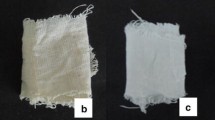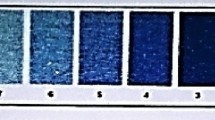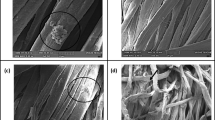Abstract
Desizing of cotton and micropoly fabrics was done using thermostable xylanase from Bacillus pumilus ASH. Micropoly fabric showed better desizing than cotton under same conditions. Violet scale readings from the TEGEWA test after enzymatic desizing for 90 min at pH 7.0 and at 60°C showed the readings falling in the range of 4–5, indicating good desizing efficiency. During bioscouring the weight loss values and liberation of reducing sugars were highest when EDTA was used along with xylanase. The weight loss value of 1.5% was observed for dry cotton fabric after 1 h in case of agitated system at pH 7.0 and at an optimal enzyme dosage of 5 IU/g. The weight loss values and the liberation of reducing sugars were higher in case of cotton fabrics. Wetting time of fabrics was lowered significantly after 60 min of bioscouring using xylanase. Increase in temperature or concentration of surfactant led to further reduction in the wetting time. The whiteness values of fabrics after bioscouring were 0.9% higher than the chemically scoured fabrics indicating good efficacy of xylanase during the scouring process.






Similar content being viewed by others
References
Sunna A, Antranikian G (1997) Xylanolytic enzymes from fungi and bacteria. Crit Rev Biotechnol 17:39–67
Gilbert HJ, Hazlewood GP (1999) Bacterial cellulases and xylanase. J Gen Microbiol 139:187–194
Battan B, Sharma JK, Kuhad RC (2006) High-level xylanase production by alkalophilic Bacillus pumilus ASH under solid-state fermentation. World J Microbiol Biotechnol 22:1281–1287
Ball AS, McCarthy AJ (1989) Saccharification of straw by actinomycete enzyme. J Appl Bacteriol 66:439–444
Hrmova M, Biely P, Vrzanka M, Petrakova E (1984) Induction of cellulose and xylan degrading enzyme complex in yeast Trichoderma cutaneum. Arch Microbiol 161:371–376
Liu W, Zhu W, Lu Y, Kong Y, Ma G (1998) Production, partial purification and characterization of xylanase from Trichosporon cutaneum SL409. Process Biochem 33:331–336
Lipp-Symonowicz B, Tanska B, Wolukanis A, Wrzosek H (2004) Influence of enzymatic treatment on the flax fibre morphological structure, physico-chemical properties and metrological parameters of yarn. Fibres Text 12:61–65
Rouette HK (2001) Encyclopedia of textile finishing. Springer, Berlin, pp 1–3, ISBN 3-540-65031-8
Karmakar SR (1999) Chemical technology in the pretreatment processes of textiles. In: Textile science and technology series, 1st edn. Elsevier Science B.V., Amsterdam, p 12
Hartzell MM, Hsieh YL (1998) Enzymatic scouring to improve cotton fabric wettability. Text Res J 68(4):233–241
Li Y, Hardin IR (1998) Enzymatic scouring of cotton-surfactants, agitation and selection of enzymes. Text Chem Color 30:23–29
Etters JN (1999) Cotton preparation with alkaline pectinase: an environmental advance. Text Chem Color Am Dyestuff Rep 1(3):33–36
Traore MK, Buschle-Diller G (1999) Environmentally friendly scouring processes. In: Book of papers of the international conference and exhibition of the AATCC, Charlotte, pp 183–189
Buchert J, Pere J, Puolakka A, Nousiainen P (2000) Scouring cotton with pectinases, proteases and lipases. Text Chem Color Am Dyestuff Rep 32(5):48–52
Csiszar E, Urbanskzi K, Szakaes G (2001) Biotreatment of desized cotton fabric by commercial cellulase and xylanase enzymes. J Mol Catal B 11:1065–1072
Yachmenev VG, Bertoniere NR, Blanchard EJ (2001) Effect of sonification on cotton preparation with alkaline pectinase. Text Res J 71(6):527–533
Lenting HBM, Zwier E, Nierstrasz VA (2002) Identifying Important Parameters for a Continuous Bioscouring Process. Text Res J 72(9):825–831
Agrawal PB, Nierstrasz VA, Warmoeskerken MMCG (2004) Enhanced Bioscouring Performance. In: Proceedings of the 4th Autex conference, Roubaix, France, 22–24 June, pp 165–173
Lenting HBM, Warmoeskerken MMCG (2004) A fast, continuous enzyme-based pretreatment process concept for cotton containing textiles. Biocatal Biotransform 22(5/6):361–368
Li Y, Hardin IR (1997) Enzymatic scouring of cotton: effects on structure and properties. Text Chem Color 29:71–76
Buchert J, Pere J, Puolakka A, Nousiainen P (1998) Enzymatic scouring of cotton. In: Book of papers, AATCC international conference and exhibition 1998, Philadelphia. Am Assoc Text Chem Color, 493–499
Losonczi A, Csiszar E, Szakacs G, Bezur L (2005) Role of the EDTA chelating agent in bioscouring of cotton. Text Res J 75(5):411–417
Verschraege L (1989) Cotton fibre impurities. Neps, motes and seed coat fragments. ICAC review articles on cotton production research No 1. CAB International, Wallingford
Csiszar E, Losonczi A, Szakacs G, Rusznak I, Bezur L, Reicher J (2001) Enzymes and chelating agents in cotton pretreatment. J Biotechnol 89(2–3):271–279
Battan B, Sharma J, Dhiman SS, Kuhad RC (2007) Enhanced production of cellulase-free thermostable xylanase by Bacillus pumilus ASH and its potential application in paper industry. Enzyme Microb Technol 41:733–739
Miller GL (1959) Use of dinitrosalicylic acid reagent for determination of reducing sugars. Anal Chem 31:426–428
Hartzell-Lawson MM, Hsieh Y-L (2000) Characterizing the non cellulosics in developing cotton fibres. Text Res J 70(9):810–819
Sindhu I, Chhibber S, Capalash N, Sharma P (2006) Production of cellulase-free xylanase from Bacillus megaterium by solid state fermentation for biobleaching of pulp. Curr Microbiol 53:167–172
Acknowledgments
The authors gratefully acknowledge Nahar Group of Industries, Punjab, India for providing cotton and micropoly fabrics and the laboratory facilities. Bindu Battan greatly acknowledges the financial assistance from Council of Scientific and Industrial Research, India in the form of Senior Research Fellowship during the course of investigation. Saurabh Sudha Dhiman and Sonia Ahlawat wish to thank Kurukshetra University, Kurukshetra for University Research Scholarship.
Author information
Authors and Affiliations
Corresponding author
Rights and permissions
About this article
Cite this article
Battan, B., Dhiman, S.S., Ahlawat, S. et al. Application of Thermostable Xylanase of Bacillus pumilus in Textile Processing. Indian J Microbiol 52, 222–229 (2012). https://doi.org/10.1007/s12088-011-0118-1
Received:
Accepted:
Published:
Issue Date:
DOI: https://doi.org/10.1007/s12088-011-0118-1




